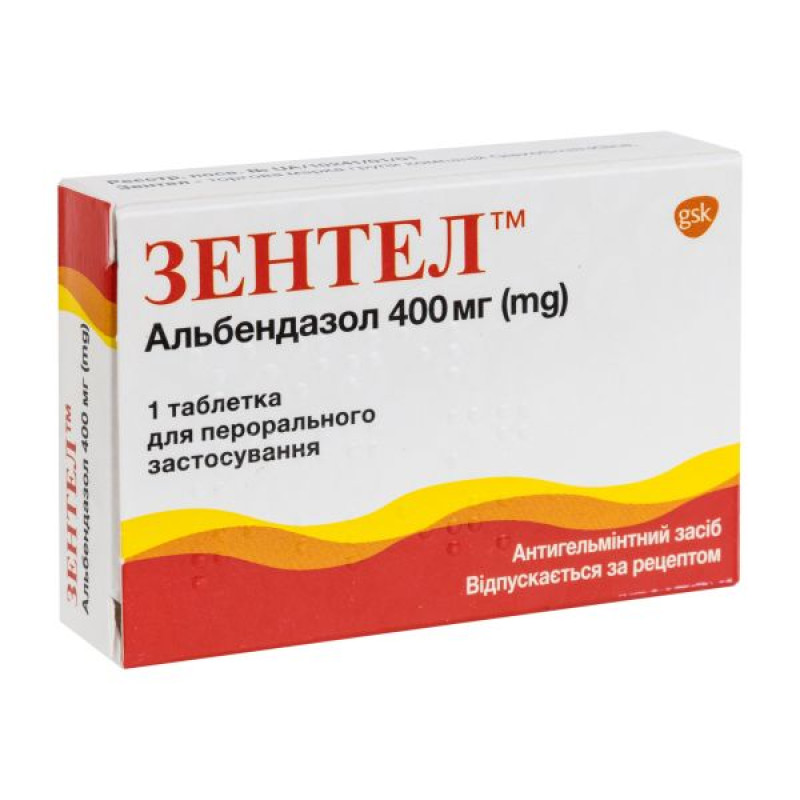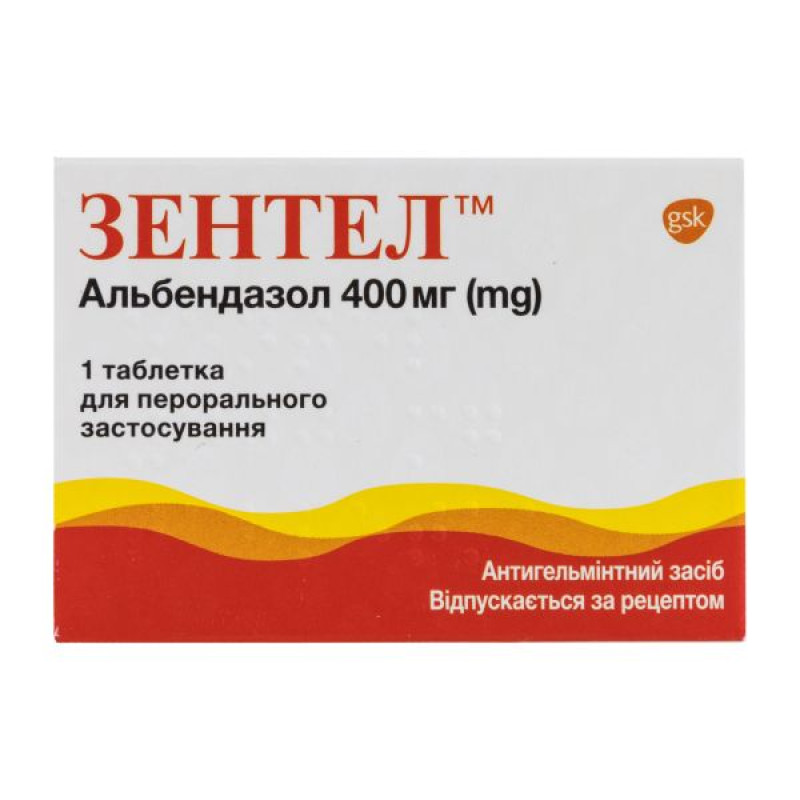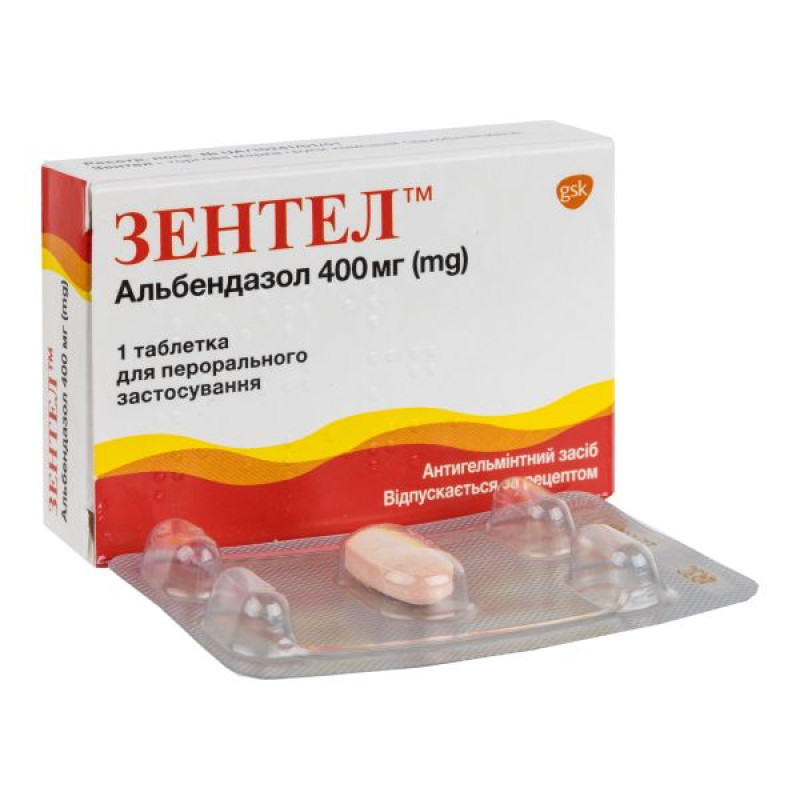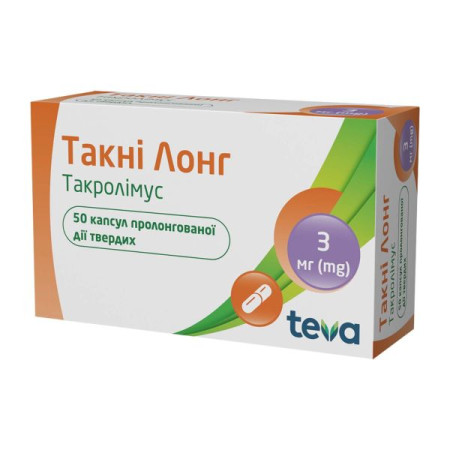Zentel tablets 400 mg No. 1

Instructions Zentel tablets 400 mg No. 1
Composition
active ingredient: albendazole;
1 tablet contains 400 mg of albendazole;
excipients: lactose monohydrate; corn starch; povidone; sodium lauryl sulfate; croscarmellose sodium; microcrystalline cellulose; sodium saccharin; magnesium stearate; dye FD&C yellow#6 Aluminum Lake 20-24% FDA; vanilla flavor; orange flavor; passion fruit flavor.
Dosage form
Pills.
Main physicochemical properties: speckled, dull orange, rounded, oblong biconvex tablets with a characteristic fruity odor, with a score line on one side of the tablet and imprinted with ALB400 on the other.
Pharmacotherapeutic group
Anthelmintic agents. Agents used in nematodoses. Benzimidazole derivatives. ATC code P02C A03.
Pharmacological properties
Pharmacodynamics
Albendazole is an antiprotozoal and anthelmintic drug from the benzimidazole carbomate group. The drug acts on both intestinal and tissue parasites in the form of eggs, larvae and adult helminths. The anthelmintic effect of albendazole is due to the inhibition of tubulin polymerization, which leads to metabolic disorders and the death of helminths.
Albendazole is active against the following intestinal parasites: nematodes - Ascaris lumbricoides, Trichuris trichiura, Enterobius vermicularis, Ancylostoma duodenale, Necator americanus, Strongyloides stercoralis, Cutaneus Larva Migrans; cestodes - Hymenolepis nana, Taenia solium, Taenia saginata; trematodes - Opisthorchis viverrini, Clonorchis sinensis; protozoa - Giardia lamblia (intestinalis or duodenalis).
Albendazole is active against tissue parasites, including cystic and alveolar echinococcosis caused by Echinococcus granulosus and Echinococcus multilocularis, respectively. Albendazole is effective in the treatment of neurocysticercosis caused by larval Taenia solium, capillariasis caused by Capillaria philippinensis, and gnathostomiasis caused by Gnathostoma spinigerum.
Albendazole destroys cysts or significantly reduces their size (up to 80%) in patients with granular echinococcosis. After treatment with albendazole, the number of nonviable cysts increases to 90% compared with 10% in untreated patients. After the use of albendazole for the treatment of cysts caused by Echinococcus multilocularis, complete recovery was observed in a minority of patients, and in the majority - improvement or stabilization of the condition.
Pharmacokinetics
When taken orally, albendazole is poorly absorbed (less than 5%). Systemic action increases if the dose of the drug is taken with fatty food, which increases the absorption of the drug by 5 times. It is rapidly metabolized in the liver during the first pass. The main metabolite is albendazole sulfate, which is the main effective substance in the treatment of tissue infections. The half-life is 8.5 hours. Albendazole sulfate and its metabolites are mainly excreted in the bile and only a small part in the urine. It has been established that with prolonged use of the drug in high doses, its elimination from cysts lasts several weeks.
Elderly patients
Although studies of the pharmacokinetics of albendazole in elderly patients have not been conducted, data obtained from the treatment of 26 patients aged up to 79 years suggest that the pharmacokinetics in this age group of patients are similar to those in young healthy volunteers.
Kidney failure
The pharmacokinetics of albendazole in this group of patients have not been studied.
Liver failure
The pharmacokinetics of albendazole in this group of patients have not been studied.
Indication
Intestinal forms of helminthiasis and cutaneous syndrome Larva Migrans (short-term treatment with low doses): enterobiasis, hookworm and necatoriasis, hymenolepidosis, teniasis, strongyloidiasis, ascariasis, trichocephalosis, clonorchiasis, opisthorchiasis, cutaneous syndrome Larva Migrans, giardiasis in children.
Systemic helminth infections (long-term treatment with high doses):
cystic echinococcosis (caused by Echinococcus granulosus):
if surgical intervention is not possible; before surgical intervention; after surgery, if preoperative treatment was short, if helminths are widespread or live forms were found during surgery; after percutaneous drainage of cysts for diagnostic or therapeutic purposes;
Alveolar echinococcosis (caused by Echinococcus multilocularis):
in inoperable disease, particularly in cases of local or distant metastases; after palliative surgery; after radical surgery or liver transplantation;
Neurocysticercosis (caused by Taenia solium larvae):
in the presence of single or multiple cysts or granulomatous brain lesions; in arachnoid or intraventricular cysts; in racemose cysts;
capillarosis (caused by Capillaria philippinensis), gnathostomiasis (caused by Gnathostoma spinigerum and related species), trichinosis (caused by Trichinella spiralis and T.pseudospiralis), toxocariasis (caused by Toxocara canis and related species).
Contraindication
Hypersensitivity to albendazole or to any component of the drug.
Pregnancy and breastfeeding.
Women planning to become pregnant. Women of reproductive age should use effective non-hormonal contraceptives during and for 1 month after treatment with the drug.
Interaction with other medicinal products and other types of interactions
Albendazole induces enzymes of the cytochrome P450 system.
Drugs that may slightly reduce the effectiveness of albendazole: anticonvulsants (e.g. phenytoin, fosphenytoin, carbamazepine, phenobarbital, primidone), levomizol, ritonavir. The effectiveness of patients' treatment should be monitored, and alternative dosage regimens or therapies may be necessary.
Cimetidine, praziquantel and dexamethasone increase plasma levels of the albendazole metabolite responsible for the systemic activity of the drug, which, in turn, may lead to an increase in the level of adverse reactions.
Grapefruit juice also increases the plasma levels of albendazole sulfoxide.
Due to possible disruption of cytochrome P450 activity, there is a theoretical risk of interaction with the following drugs: oral contraceptives, anticoagulants, oral hypoglycemic agents, theophylline.
Application features
Treatment of intestinal forms of helminthiasis and cutaneous syndrome Larva Migrans
To prevent early pregnancy, women of reproductive age should be treated during the first week of menstruation or after a negative pregnancy test. Reliable contraception is required during treatment.
Treatment with albendazole may reveal pre-existing neurocysticercosis, especially in areas with high levels of infection with Taenia solium strains. Patients may develop neurological symptoms, such as seizures, increased intracranial pressure, and focal symptoms due to the inflammatory response caused by the death of the parasites in the brain. Symptoms may occur rapidly after treatment, so appropriate therapy with corticosteroids and anticonvulsants should be initiated immediately.
Treatment of systemic helminth infections
Albendazole treatment is associated with mild to moderate elevations in liver enzymes, which usually return to normal after discontinuation of treatment. Cases of hepatitis have been reported. Therefore, liver enzymes should be monitored before each course of treatment and at least every 2 weeks during treatment. If liver enzymes increase significantly (more than 2 times the upper limit of normal), albendazole treatment should be discontinued. Treatment may be resumed after normalization of the enzymes, but the patient should be closely monitored.
Albendazole may cause bone marrow suppression, therefore, the patient's blood tests should be performed both at the beginning of treatment and every 2 weeks during the 28-day cycle. Patients with liver disease, including hepatic echinococcosis, are more prone to bone marrow suppression, resulting in pancytopenia, aplastic anemia, agranulocytosis and leukemia, which necessitates careful monitoring of blood counts. In the event of a significant decrease in blood counts, treatment should be discontinued (see sections "Method of administration and dosage" and "Adverse reactions").
To prevent taking Zentel in early pregnancy, women of reproductive age should:
start treatment only after a negative pregnancy test; warn about the need to use effective contraception during treatment with the drug and for a month after its discontinuation.
Patients with neurocysticercosis treated with albendazole may experience symptoms (e.g., seizures, increased intracranial pressure, and focal symptoms) related to the inflammatory response caused by the death of the parasites. Such adverse reactions should be treated with corticosteroids and anticonvulsants. Oral or intravenous corticosteroids are recommended to prevent cases of increased cerebral pressure during the first week of treatment.
Albendazole treatment may also reveal pre-existing neurocysticercosis, especially in areas with high levels of Taenia solium infection. Patients may develop neurological symptoms, such as seizures, increased intracranial pressure, and focal symptoms due to the inflammatory response caused by the death of the parasites in the brain. Symptoms may occur rapidly after treatment, so appropriate therapy with corticosteroids and anticonvulsants should be initiated immediately.
Since the drug contains lactose, patients with rare hereditary problems of galactose intolerance, the Lapp lactase deficiency or glucose-galactose malabsorption should not take this medicine.
The drug contains sodium saccharin, which should be taken into account by patients with diabetes.
Ability to influence reaction speed when driving vehicles or other mechanisms
Given the presence of such a side effect as dizziness, it is recommended to refrain from driving or operating other mechanisms during the period of use of albendazole.
Method of administration and doses
Intestinal infections and cutaneous syndrome Larva Migrans
Some patients, especially children, may have difficulty swallowing the tablet whole, in which case the tablet can be chewed with a small amount of water or crushed.
For use in adults and children aged 3 years and over.
| Infection | Age | Dosage and duration of administration |
| Enterobiasis, hookworm, necatoriasis, ascariasis, trichocephalosis | Adults and children aged 3 years and over* | 400 mg 1 time/day (1 tablet) once. |
| Strongyloidiasis, taeniasis, hymenolepidosis | Adults and children aged 3 years and over* | 400 mg 1 time/day (1 tablet) for 3 days. For hymenolepidosis, a repeated course of treatment is recommended in the interval from the 10th to the 21st day after the previous course. |
| Clonorchiasis, opisthorchiasis | Adults and children aged 3 years and over* | 400 mg 1 tablet 2 times a day for 3 days. |
| Cutaneous Larva Migrans Syndrome | Adults and children aged 3 years and over* | 400 mg 1 tablet once a day for 1-3 days. |
| Giardiasis | Only children aged 3 to 12 years* | 400 mg 1 tablet once a day for 5 days. |
* For children aged 2 to 3 years, use another form of the drug - a suspension for oral administration.
Elderly patients
Experience in the elderly is limited. No dose adjustment is required, but albendazole should be used with caution in elderly patients with impaired liver function.
Kidney failure
Since albendazole is excreted by the kidneys in very small amounts, dose adjustment is not required for the treatment of this category of patients, however, if there are signs of renal failure, such patients should be closely monitored.
Liver failure
Since albendazole is extensively metabolized in the liver to a pharmacologically active metabolite, hepatic impairment may have a significant effect on its pharmacokinetics. Therefore, patients with altered liver function (elevated transaminases) should be closely monitored when starting albendazole.
Systemic helminth infections (long-term treatment with high doses).
Take the drug with food.
For use in adults and children aged 6 years and over.
High doses of the drug are not recommended for children under 6 years of age. The dosage regimen is set individually by the doctor depending on age, body weight, and the severity of the infection.
The dose for patients with a body weight of more than 60 kg is 400 mg (1 tablet) 2 times a day. For patients with a body weight of less than 60 kg, the drug is prescribed at the rate of 15 mg/kg/day. This dose should be divided into 2 doses. The maximum daily dose is 800 mg.
| Infection | Duration of reception |
| Cystic echinococcosis | 28 days. The 28-day cycle can be repeated (a total of 3 times) after a 14-day break. |
| Inoperable and multiple cysts | Up to 3 28-day cycles for the treatment of hepatic, pulmonary and peritoneal cysts. In the presence of cysts of other localization (in the bones or brain), longer treatment may be required. |
| Before surgery | Two 28-day cycles are recommended before surgery. If surgery is to be performed before these cycles are completed, treatment should be continued as long as possible before surgery. |
After surgery After percutaneous cyst drainage | If a short course of treatment (less than 14 days) was received before surgery or in the case of emergency surgery, two cycles of 28 days should be performed after surgery, separated by a 14-day break in the use of the drug. Similarly, if viable cysts are found or helminth dissemination has occurred, two full cycles of treatment should be administered. |
Alveolar echinococcosis Neurocysticercosis** | 28 days. The second 28-day course should be repeated after a two-week break in the use of the drug. Treatment can be extended for several months or years. The duration of treatment is from 7 to 30 days. The second course can be repeated after a two-week break in the use of the drug. |
| Parenchymal cysts and granulomas | The usual duration of treatment is from 7 days (minimum) to 28 days. |
| Arachnoid and intragastric cysts | The usual course of treatment is 28 days. |
| Racemose cysts | The usual course of treatment is 28 days, but may be longer. The duration of treatment is determined by the clinical and radiological response to treatment. |
** Appropriate corticosteroid and anticonvulsant therapy should be administered in patients with neurocysticercosis. Oral and intravenous corticosteroids are recommended to prevent cerebral hypertension during the first week of treatment.
| Infection | Dosage and duration of administration |
| Capillariasis | 400 mg once daily for 10 days***. |
| Gnathostomiasis | 400 mg once daily for 10-20 days***. |
| Trichinosis, toxocariasis | 400 mg 2 times a day for 5-10 days***. |
***Usually one course of treatment is required, but subsequent courses may be necessary if parasitological examination results remain positive.
Experience in the elderly is limited. No dose adjustment is required, but albendazole should be used with caution in elderly patients with impaired liver function.
Kidney failure
Since albendazole is excreted by the kidneys in very small amounts, dose adjustment is not required for the treatment of this category of patients, however, if there are signs of renal failure, such patients should be closely monitored.
Liver failure
Children
The drug is intended for use in children aged 3 years and older. For the treatment of children aged 2 to 3 years, another dosage form is recommended – a suspension for oral administration.
Overdose
Symptoms, depending on the dose of the drug, may include diarrhea, nausea, vomiting, tachycardia, increased transaminase levels. In case of overdose, treatment is symptomatic, according to the clinical condition.
Side effects occurring during short-term treatment of intestinal infections and cutaneous syndrome Larva Migrans.
Immune system.
Rare: hypersensitivity reactions including rash, itching and urticaria.
Nervous system.
Uncommon: headache and dizziness.
Gastrointestinal tract.
Uncommon: upper gastrointestinal symptoms (e.g. epigastric pain, nausea, vomiting) and diarrhoea.
Hepatobiliary system.
Rare: increased liver enzymes.
Skin and subcutaneous tissue.
Very rare: erythema multiforme, Stevens-Johnson syndrome.
Side effects that occur during long-term treatment of systemic helminth infections.
Blood and lymphatic system.
Uncommon: leukopenia.
Very rare: pancytopenia, aplastic anemia, agranulocytosis.
Patients with liver disease, including hepatic echinococcosis, are more susceptible to bone marrow suppression (see sections “Method of administration and dosage” and “Special warnings and precautions for use”).
Immune system.
Uncommon: hypersensitivity reactions including rash, pruritus and urticaria.
Nervous system.
Very common: headache.
Common: dizziness.
Gastrointestinal tract.
Common: gastrointestinal disorders (abdominal pain, nausea, vomiting). These phenomena are associated with the treatment of patients with echinococcosis with albendazole.
Hepatobiliary system.
Very common: mild to moderate elevations in liver enzymes.
Uncommon: hepatitis.
Skin and subcutaneous tissue.
Common: alopecia areata (hair thinning and moderate hair loss).
Very rare: erythema multiforme, Stevens-Johnson syndrome.
General disorders.
Common: fever.
The drug contains the dye FD&C yellow#6 Aluminum Lake 20-24% FDA, which may cause allergic reactions.
Expiration date
5 years.
Storage conditions
Store below 30 °C. Keep out of the reach of children.
Packaging
1 tablet in a PVC/aluminum foil blister, placed in a cardboard box.
Vacation category
According to the recipe.
Producer
GlaxoSmithKline Consumer Healthcare South Africa (Pty) Ltd, Republic of South Africa.
Location of the manufacturer and its business address
GlaxoSmithKline Consumer Healthcare South Africa (Pty) Ltd, 39 Hawkins Avenue, Epping Industria 1, 7460, Cape Town, Republic of South Africa.
There are no reviews for this product.
There are no reviews for this product, be the first to leave your review.
No questions about this product, be the first and ask your question.















